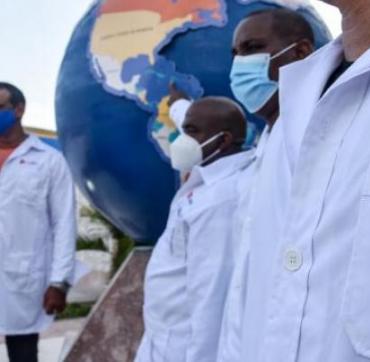Significant contributions by Cuban science to the battle against COVID-19
especiales

The priority given by the Revolution, since its very beginnings, to create the human capital necessary to promote the country’s scientific development, building required infrastructure and inserting ourselves, almost three decades later, into the nascent biotechnology industry under Fidel's guidance, made it possible for Cuba to respond immediately to the health emergency caused by the arrival of COVID-19 to the country, last March.
From that moment on, our national system of science, technology and innovation, characterized by its comprehensive and multisectoral approach, along with the selfless efforts of doctors, nurses, technicians and other health workers, became the country’s main strengths in the battle against the pandemic and made it possible to obtain results that place us among nations with the lowest lethality in the Americas and at the international level, without mourning the death of a single child or the collapse of intensive care units, in addition to maintaining low numbers of patients in serious or critical condition, to cite some of the most important accomplishments.
Granma presents below a review of the principal contributions made by Cuban science in this colossal battle to save lives.
-Inclusion of human recombinant Interferon ALFA 2B (its commercial name is Heberón) in treatment protocols since the first cases appeared. According to data from the Ministry of Public Health (Minsap), as of April 14, 2020, 93.4% of patients carrying the new sars-cov-2 had been treated with this drug and only 5.5% reached serious condition. The mortality rate reported on that date was 2.7%, while among patients receiving this treatment the rate was 0.9%.
-Use of models designed by the Mathematics and Computing department at the University of Havana, in collaboration with other institutions, to predict the evolution of the epidemic.
-More than 20 Cuban medicines are currently included in protocols for the treatment and prevention of COVID-19.
-With the appearance of the first cases of COVID-19 in Cuba, the National Center of Biopreparations (Biocen) devoted itself to the manufacture of several of the main drugs of our biotechnological industry that are used to treat SARS-COV-2 infections.
-The development by BioCen researchers of the first transport medium for viruses (BTV) produced in Cuba, used in the collection and transfer of patients' nasopharyngeal and oropharyngeal samples for the diagnosis of SARS-COV-2, can be described as a real milestone.
-Development of new diagnostics for SARS-COV-2 by the Immunoassay Center.
-The creation of the first prototype of a Cuban ventilator for assisted respiration, as a result of a joint effort by the Neurosciences Center, the Grito de Baire Enterprise affiliated with the Military Industries Union, the Combiomed Enterprise, the Center for the State Control of Medicines, Equipment and Medical Devices (CECMED) and the National Design Office. Some 250 of these ventilators are to be distributed across the national public health system.
-Led by the Hematology and Immunology Institute, in May, clinical trials began of stem cell treatment of pulmonary sequelae in patients recovering from COVID-19.
-More than 80 research projects related to COVID-19 have been completed or are underway since the outbreak of the pandemic.
-Eight Cuban academics were chosen as international advisors for the battle against the disease around the world. They are Luis Velázquez Pérez, Pedro Más Bermejo, Luis Herrera Martínez, Luis Carlos Silva, Tania Crombet Ramos, Guadalupe Guzmán Tirado, Jorge Núñez Jover and Rafael Bello Pérez.
-On August 24, Cuba began clinical trials of its first candidate vaccine, under the name of SOBERANA 01, developed by scientists at the Finlay Vaccine Institute.
-In early November, phase 1clinical trials of a second candidate vaccine named Sovereign 02 were announced. According to Dr. Vicente Vérez Bencomo, general director of the Finlay Vaccine Institute, it is a conjugated vaccine, unlike any other under development around the world, in which the antigen of the virus is chemically linked to the tetanus toxoid.
-Researchers from the Center for Genetic Engineering and Biotechnology (CIGB) developed two other candidate vaccines, known as Mambisa and Abdala. The first is to be administered nasally, while administration of the second is intramuscular. Both received authorization from CECMED to begin clinical trials at the end of November, giving Cuba a total of four candidates in clinical trials, a significant accomplishment for the nation’s biotechnological and pharmaceutical industry.














Add new comment